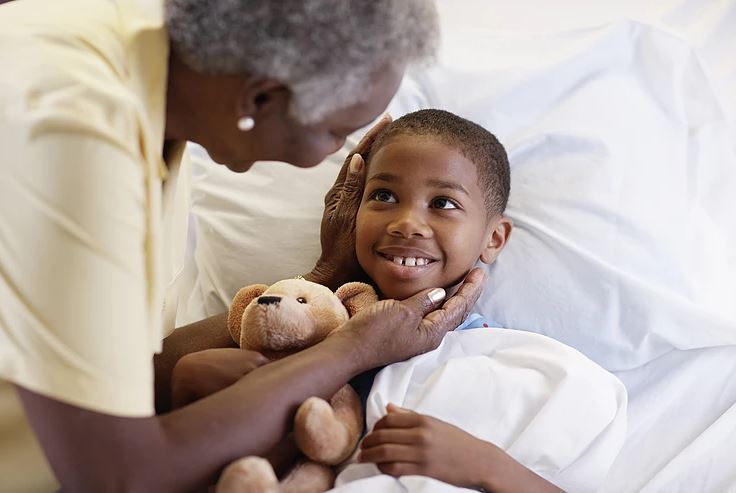Many people have heard of the famous study that communication is 7% verbal and 93% non-verbal. Non-verbal communication include things like tone of voice, body language, and facial expressions. While most of these signals are so subtle that we aren’t aware of them, research reveals that there are several different types of nonverbal communications that have an effect on how our message is received. The importance of nonverbal communication is especially significant when we are conversing with someone who has dementia or a language processing deficit, as they have increased difficulty processing the spoken words and rely on the greater impact on the perceived nonverbals.
Let’s first examine some of the most common nonverbals we use in communication:
1. Facial Expressions
Perhaps the most prominent type of nonverbal communication is facial expression. The look on someone’s face is one of the first things we see when we look at them. Before we even know what someone is going to say, we can tell if it’s going to be positive or negative. We just look to see if the person you are talking to is wearing a smile or a frown on their face. Although many cultures have different communication styles, there are some universal facial expressions. These include the expressions for emotions such as happiness, sadness, anger and fear. So remember before you approach someone with dementia, be sure to wear a soft facial expression and a smile on your face to create the most positive interaction. Use of a mirror to monitor your facial expressions is beneficial to ensure you are not using making unintentional faces that confuse your message.
2. Gestures
The use of our body to signal or indicate meaning without words is referred to as gesturing. This consists of things such as waving, pointing, using fingers to indicate numeric amounts, tilting head, touching the nose, etc. Like facial expressions, gestures are also influenced by culture, but movements like the shoulder shrug and pointing are generally universal. Use of these important nonverbal gestures can often replace the need to use verbal communication at all. Has your teenager ever grabbed their head or thrown their hands up in the air when you’ve asked them to do something? Have you seen someone give the middle finger while they are driving? This is a perfect demonstration of the importance of nonverbal communication. Many people are said to talk with their hands, a stereotype shared by both Italians and Jews, which often further amplifies their message. So, when communicating with someone who has language impairments, be sure that your gestures further exemplify your intended meaning.
3. Proximity
 Proxemics, also referred to as “personal space”, is another important type of nonverbal communication to consider. The amount of personal space we need is influenced by a number of factors including social norms, cultural expectations, situational factors, personality and level of familiarity. Many of us have experienced a “close talker”. This may actually be a result of different cultural norms. For example, in Argentina, the amount of personal space comfortable between strangers is approx 2.5 feet. In the US, personal space preference is approximately 3 feet. In Rome, a comfortable personal space is over 4.5 feet. Therefore, it’s important to be mindful of your distance to others – too close may make someone uncomfortable, while too far may seem uncaring or disinterested. When dealing with people with dementia or language impairment persons, be sure to keep an appropriate amount of space between you and your partner. Standing too close to someone can make them feel like they are being attacked or trapped, while being too far away will reduce their ability to maintain attention to the person they are conversing with. Distance matters.
Proxemics, also referred to as “personal space”, is another important type of nonverbal communication to consider. The amount of personal space we need is influenced by a number of factors including social norms, cultural expectations, situational factors, personality and level of familiarity. Many of us have experienced a “close talker”. This may actually be a result of different cultural norms. For example, in Argentina, the amount of personal space comfortable between strangers is approx 2.5 feet. In the US, personal space preference is approximately 3 feet. In Rome, a comfortable personal space is over 4.5 feet. Therefore, it’s important to be mindful of your distance to others – too close may make someone uncomfortable, while too far may seem uncaring or disinterested. When dealing with people with dementia or language impairment persons, be sure to keep an appropriate amount of space between you and your partner. Standing too close to someone can make them feel like they are being attacked or trapped, while being too far away will reduce their ability to maintain attention to the person they are conversing with. Distance matters.
4. Paralinguistics
Paralinguistics are components of meta-communication that can affect meaning such as use of prosody, pitch, volume intonation, etc. This is probably best seen when used in the response, “fine”. For example, a husband asks his wife how she’s feeling after a recent argument and she says “fine” curtly with sharp inflection. We can easily surmise that her response meaning is quite different than when a friend asks her how she is feeling after hearing good news and she replies “fine” with a chipper and enthusiastic tone. The tone and volume of your speech is another great example of the importance of nonverbal communication. Variation in these two voice features add a lot of meaning to words, so the same word can sound very different when used with various paralinguistic factors. For impaired communication persons, use appropriate inflection, rate and tone that mirrors your intended message. Remember that positive communication is often better received than negative communication.
5. Touch
There has been a substantial amount of research on the importance of touch during infancy and early childhood in development of behavior and social interaction. Physical contact is often used differently by men and women, as well as between socioeconomic statuses. For example, women often use touch to convey care, concern and nurture. In contrast, men are more likely to use touch to assert power or control over another. Think about a woman who sees her friend and grabs her hand to offer encouragement and love. This is in contrast to a man who grabs his friend’s hand to greet him and exerts a forceful handshake to convey assertiveness and strength. In addition to the differences in gender for use of haptics, those with a higher perceived status will often invade personal space and use touch (such as shoulder tap or pat on the head) than those of lower perceived status. Using physical touch (hug, handshake, arm rub) as a part of communication can serve to reassure another when used gently and appropriately. This is further evidence of the importance of nonverbal communication to convey sentiment and meaning. When using touch with dementia or language impaired persons, use of touch can serve to gain attention, convey care or gently direct movement for functional tasks.
6. Body Language and Posture
The way that someone moves and carries themselves can say a lot about them, their mood and their state of mind. How would you guess someone is feeling if they have their shoulder rounded forward and their head hanging down looking at the floor? Elated or disappointed? Although many body postures can be more subtle as often identified by psychologist who study body language. Different body postures as it relates to love, work and relationships. For example, the direction your feet are pointing or whether or not you are leaning towards someone while talking can indicate your interest in the conversation. Other movements such as arms crossing or hands on hips can be overtly obvious in meaning. To ensure maximum effectiveness in your communication, use open and confident communication with impaired persons to reduce the risk of sending mixed signals. This is again a beneficial time to use a mirror or recording of yourself to analyze your body language.
7. Eye Gaze
For people who can see, vision is the most dominant of all five senses. This is why eye contact is so important in communication. The amount of visual interaction can signify a person’s interest, engagement or intent. Normal, steady eye contact is considered to be representative of someone who is telling the truth. Conversely, someone with a shifty gaze may be perceived as lying or being deceptive. We also use eye gaze as non-verbal communication when we blink, stare, or leer at another. Anyone else feel a chill when a stranger seems to be looking intently right into your eyes? The importance of nonverbal communication when using the eyes can create solace or discomfort depending on the intensity of the eye contact being made. We have all seen the mother who leers at her children when they are acting up. Establishing steady eye contact with soft eyes will allow those with deficits to maintain awareness and feel comforted in the interaction taking place.
8. Appearance
Perhaps the thing we are judged on the most by others is our appearance, which can play a large role in nonverbal communication. Going to a job interview or meeting a new potential mate can be greatly influenced by our first impressions. Think about how quickly we make judgement and assumption based on a person’s outward appearance. A man in a suit and tie can suggest a person of greater importance than a man in gym clothes and tennis shoes. Research also indicates that color can play a large role in our inferencing, hence the “power red tie”. Many cultures have a specific beauty standard. Those who score in the higher percentile of attractiveness are often perceived as smarter and more successful, and often make more money than their less attractive peers. Have you even met someone new who reminded you of someone you already know? Do you feel a stronger attraction to them? Most do, despite the person still being a total stranger. This phenomenon can explain why looks are of one of the features of great importance of nonverbal communication. When presenting yourself to someone with dementia or language impairment, be sure your appearance is not disheveled or unkempt as your message will be perceived as less trustworthy.
9. Artifacts
Environmental objects and cues can also play a role in our ability to communicate with others. If we see someone walking down the street in fatigues, we surmise he/she is in the military, someone in a lab coat likely works in the health or medical field, and someone wearing a name badge is assumed to be in the service industry. The ability to effectively relay information nonverbally is occasionally relied upon by certain professions, such as police officers in uniform which automatically garner respect and attention when encountered. The unconscious recognition of objects and uniform garments serve to reinforce the desired messages without need for indication of seriousness. We know from experience that communication with medical professionals, law enforcement and court officials, such as judges, are likely to be important and earnest in content. For individuals with communication impairments, use of these artifacts will signify the need for heeding the message being shared.
So as you can see, the importance of nonverbal communication play a critical role in how we transmit meaning and information to others. We must remember to be consistent with our words, actions and presentation in order to ensure we communicate exactly what it is we are trying to convey. The grouping of any number of these non-verbals together easily shows the relationship as to why nonverbals hold 93% of the communication power. So the next time you interact with someone, be sure to monitor both your words and your appearance. For language impaired and dementia persons, your visual cues are often the only communication they perceive. Ensure you send the right message to achieve the desired response.
If you enjoyed this article, you may also be interested in:
How to Talk With Your Dementia Loved One








